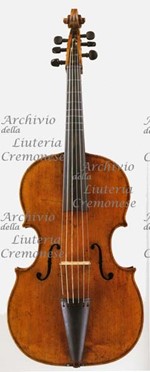1611 - Tenor Viol
The belly is two-piece of spruce of medium grain, with f-holes. In the middle of the c-bouts, the are purfling joints. It has little breakings near the lower and upper boards. The back is one piece of maple, of marked and soft curl, cut on the slab. It is round to the “bump”, which is flat. The nose, partially not original, is carved with the letter “W”, that can be also inerpreted as a letter “M”. The ribs are five-piece of wood similar to the back, with breakings in the lower bouts (fixed with little blocks) and in the upper left bout, which has plastering to repair damages produced by woodworms. The pegbox is original, the fitting up modified from 6 to 4 strings and then back to 6 strings. The varnish is golden yellow, not coloured. The fitting up with 5 strings is modern.
- 7,3 cm
- 7,4 cm
- 5,1 cm
- 1611, Cremona
- Antonio et Hieronimus fr Cremonen Andreae fil 1611 (very damaged)
- 16,8 cm
- 31,1 cm
- 25,1 cm
- 3,85 cm
- 5,2 cm
- 50,1 cm
- The letter "M" on the nose, similar to the one on the bass viola "Oxford", could mean "Medici". Consequently, the instrument comes from Firenze;
- Mosca RU), National Collection
- A. S. Kochergin, 1988
- Madame Popov (Simferopol) 1920; Russian State Collection 1948
- 1938, Cremona: Espozione di Liuteria Antica Cremonese; 2006, Cremona: Il DNA degli Amati
- AA.VV. 1988; S. a. 2004 (I); Cacciatori-Carlson-Chiesa 2006
| creato: | giovedì 8 marzo 2012 |
|---|---|
| modificato: | giovedì 23 marzo 2017 |


